
|
Image-GoddenB18
Railway support structure, Royal Gorge. Simple 3-hinge structure consisting of two straight struts, pinned to each side of the gorge. Center pin supports the side of a girder bridge for railway line (the other side being supported directly on the cliff face). Good example for illustrating boundary forces in a 3-hinged arch. (Colorado)
|
|

|
Image-GoddenB18.1
Three-hinged footbridge over a freeway in England. This simple concrete structure is hinged at both supports and at midspan, and represents the most elementary use of a three-hinged arch. (England)
|
|
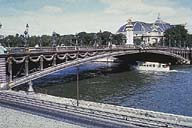
|
Image-GoddenB19
Pont Alexandre III. Built across River Seine in 1890. Steel arch is a 350 ft. span ellipse with a rise/span ratio of 1/17. Note the variation in arch section. (Paris, France)
|
|
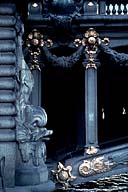
|
Image-GoddenB20
Pont Alexandre III. Detail of bridge structure. Note the gilt ornamentation covering the support pin at the end of the arch rib, and also the casting over the gap in the parapet and deck expansion joint at the top of the slide. Without appropriate deck discontinuities, the bridge would not behave as a simple 3-hinged structure. (Paris, France)
|
|
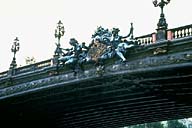
|
Image-GoddenB21
Pont Alexandre III. Detail of mid-span hinge in the bridge. Ornamentation on outside hinge can be seen, together with the line of hinges in the internal arch ribs. (Paris, France)
|
|
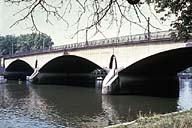
|
Image-GoddenB22
Twickenham Bridge over the river Thames. Designed as a series of independent 3-hinged arch spans in reinforced concrete. In this design the hinges are continuous line concrete-on-concrete bearings over the full width of the bridge. (London, England)
|
|
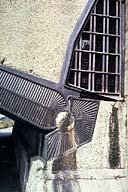
|
Image-GoddenB23
Twickenham Bridge over the River Thames. Detail of end abutment bearing. The hinge can easily be seen in this slide, but the steel facing is largely ornamental. (London, England.)
|
|

|
Image-GoddenB24
Pont d'Austerlitz, a 3-hinged railway bridge across the River Seine. Note that it is not necessary for the hinges to be at the abutment. In this design the outer hinges are internal to the structure and at deck level. The arch rib section is a variable depth truss. (Paris, France)
|
|
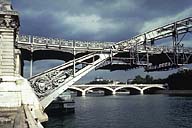
|
Image-GoddenB25
Pont d'Austerlitz, a 3-hinged railway bridge across the River Seine. Detail of deck-level hinges. The hinge is supported from the abutment on a long tapered truss pedestal. The taper is necessary on account of the variation in live load position altering the direction of the resultant thrust on the pin. (Paris, France)
|
|
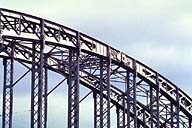
|
Image-GoddenB26
Pont d'Austerlitz, a 3-hinged railway bridge across the River Seine. Detail of the mid-span hinge. (Paris, France)
|
|
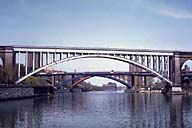
|
Image-GoddenB27
Three arches over the Harlem River. Similar except the High Bridge (white, 1848) is 3-hinged, Alexander Hamilton Bridge (blue) is fixed arch, and Washington Traffic Bridge (red) is 2-hinged. Moment resistance taken by road level girder (nearest bridge) and by arch ribs (other two) For detail of Washington Traffic Bridge, see GoddenB34. (New York City)
|
|
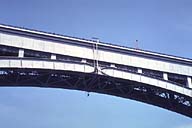
|
Image-GoddenB28
Detail of mid-span hinge of High Bridge (see GoddenB27). Interestingly the road level girder has no discontinuity at midspan above the arch hinge, hence the complete structure will not act as a simple 3-hinged arch. (New York City)
|
|
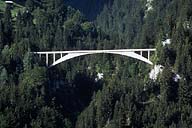
|
Image-GoddenB28.1
Salginatobel Bridge (1930) in the Davos Alps, Switzerland. This well-known 3-hinged concrete arch bridge designed by Robert Maillart has a span of 90 meters and a rise of 13 meters. The arch rib increases in depth from the supports to the quarter-span points where it becomes integral with the deck, and tapers to the mid-span hinge. This bridge was designated as an International Historic Civil Engineering Landmark in 1991. (Davos Alps, Switzerland)
|
|
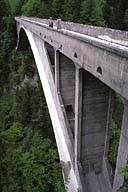
|
Image-GoddenB28.2
End view of the Salginatobel Bridge, showing details of the arch rib and spandrel walls (see also GoddenB28.1) (Davos Alps, Switzerland)
|
|
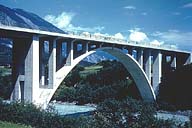
|
Image-GoddenB28.3
Reinforced concrete highway bridge. Although the arch rib itself is three-hinged, the spandrel walls, which are integral with both the arch and the continuous road level girder, make the behavior of the bridge highly redundant. The mid-span hinge in the arch can be seen, together with the split spandrel wall at mid-span. Note that both the arch rib and the spandrel columns are continuous over the width of the bridge, unlike the designs of GoddenB67-B72. (Near Innsbruck, Austria)
|
|

















